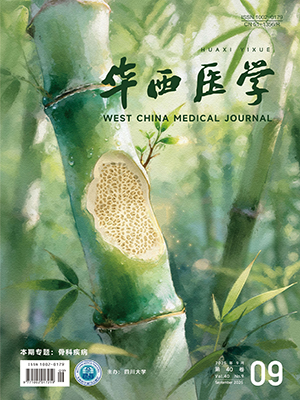| 1. |
Wimmer C, Gluch H. Management of postoperative wound infection in posterior spinal fusion with instrumentation[J]. J Spinal Disord, 1996, 9(6):505-508.
|
| 2. |
Beiner JM, Grauer J, Kwon BK, et al. Postoperative wound infections of the spine[J]. Neurosurg Focus, 2003, 15(3):E14.
|
| 3. |
Kim KW, Ha KY, Kim MS, et al. Postoperative trichosporon asahii spondylodiscitis after open lumbar discectomy:a case report[J]. Spine (Phila Pa 1976), 2008, 33(4):E116-E120.
|
| 4. |
Kang BU, Lee SH, Ahn Y, et al. Surgical site infection in spinal surgery:detection and management based on serial C-reactive protein measurements[J]. J Neurosurg Spine, 2010, 13(2):158-164.
|
| 5. |
Nunes BK, Lacerda RA, Jardim JM. Systematic review and meta-analysis of the predictive value of C-reactive protein in postoperative infections[J]. Rev Esc Enferm USP, 2011, 45(6):1488-1494.
|
| 6. |
Hong HS, Chang MC, Liu CL, et al. Is aggressive surgery necessary for acute postoperative deep spinal wound infection?[J]. Spine (Phila Pa 1976), 2008, 33(22):2473-2478.
|
| 7. |
Mirovsky Y, Floman Y, Smorgick Y, et al. Management of deep wound infection after posterior lumbar interbody fusion with cages[J]. J Spinal Disord Tech, 2007, 20(2):127-131.
|
| 8. |
Soultanis K, Mantelos G, Pagiatakis A, et al. Late infection in patients with scoliosis treated with spinal instrumentation[J]. Clin Orthop Relat Res, 2003(411):116-123.
|
| 9. |
Sierra-Hoffman M, Jinadatha C, Carpenter JL, et al. Postoperative instrumented spine infections:a retrospective review[J]. South Med J, 2010, 103(1):25-30.
|
| 10. |
Jones GA, Butler J, Lieberman I, et al. Negative-pressure wound therapy in the treatment of complex postoperative spinal wound infections:complications and lessons learned using vacuum-assisted closure[J]. J Neurosurg Spine, 2007, 6(5):407-411.
|
| 11. |
Venturi ML, Attinger CE, Mesbahi AN, et al. Mechanisms and clinical applications of the vacuum-assisted closure (VAC) device:a review[J]. Am J Clin Dermatol, 2005, 6(3):185-194.
|
| 12. |
Defranzo AJ, Argenta LC, Marks MW, et al. The use of vacuum-assisted closure therapy for the treatment of lower-extremity wounds with exposed bone[J]. Plast Reconstr Surg, 2001, 108(5):1184-1191.
|
| 13. |
Fox A, Tadros A, Perks AG. An unusual complication of Vacuum Assisted Closure in the treatment of a pressure ulcer[J]. J Wound Care, 2004, 13(8):344-345.
|
| 14. |
Gwan-Nulla DN, Casal RS. Toxic shock syndrome associated with the use of the vacuum-assisted closure device[J]. Ann Plast Surg, 2001, 47(5):552-554.
|
| 15. |
Friedman T, Westreich M, Shalom A. Vacuum-assisted closure treatment complicated by anasarca[J]. Ann Plast Surg, 2005, 55(4):420-421.
|
| 16. |
Labler L, Keel M, Trentz O, et al. Wound conditioning by vacuum assisted closure (V.A.C.) in postoperative infections after dorsal spine surgery[J]. Eur Spine J, 2006, 15(9):1388-1396.
|




